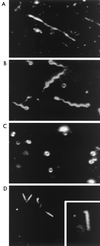The flagellar filament of Rhodobacter sphaeroides: pH-induced polymorphic transitions and analysis of the fliC gene
- PMID: 10960108
- PMCID: PMC94672
- DOI: 10.1128/JB.182.18.5218-5224.2000
The flagellar filament of Rhodobacter sphaeroides: pH-induced polymorphic transitions and analysis of the fliC gene
Abstract
Flagellar motility in Rhodobacter sphaeroides is notably different from that in other bacteria. R. sphaeroides moves in a series of runs and stops produced by the intermittent rotation of the flagellar motor. R. sphaeroides has a single, plain filament whose conformation changes according to flagellar motor activity. Conformations adopted during swimming include coiled, helical, and apparently straight forms. This range of morphological transitions is larger than that in other bacteria, where filaments alternate between left- and right-handed helical forms. The polymorphic ability of isolated R. sphaeroides filaments was tested in vitro by varying pH and ionic strength. The isolated filaments could form open-coiled, straight, normal, or curly conformations. The range of transitions made by the R. sphaeroides filament differs from that reported for Salmonella enterica serovar Typhimurium. The sequence of the R. sphaeroides fliC gene, which encodes the flagellin protein, was determined. The gene appears to be controlled by a sigma(28)-dependent promoter. It encodes a predicted peptide of 493 amino acids. Serovar Typhimurium mutants with altered polymorphic ability usually have amino acid changes at the terminal portions of flagellin or a deletion in the central region. There are no obvious major differences in the central regions to explain the difference in polymorphic ability. In serovar Typhimurium filaments, the termini of flagellin monomers have a coiled-coil conformation. The termini of R. sphaeroides flagellin are predicted to have a lower probability of coiled coils than are those of serovar Typhimurium flagellin. This may be one reason for the differences in polymorphic ability between the two filaments.
Figures







Similar articles
-
A chimeric N-terminal Escherichia coli--C-terminal Rhodobacter sphaeroides FliG rotor protein supports bidirectional E. coli flagellar rotation and chemotaxis.J Bacteriol. 2005 Mar;187(5):1695-701. doi: 10.1128/JB.187.5.1695-1701.2005. J Bacteriol. 2005. PMID: 15716440 Free PMC article.
-
Structural Characterization of the Fla2 Flagellum of Rhodobacter sphaeroides.J Bacteriol. 2015 Sep;197(17):2859-66. doi: 10.1128/JB.00170-15. Epub 2015 Jun 29. J Bacteriol. 2015. PMID: 26124240 Free PMC article.
-
Point mutations that lock Salmonella typhimurium flagellar filaments in the straight right-handed and left-handed forms and their relation to filament superhelicity.J Mol Biol. 1991 Jul 5;220(1):79-88. doi: 10.1016/0022-2836(91)90382-g. J Mol Biol. 1991. PMID: 2067020
-
The archaeabacterial flagellar filament: a bacterial propeller with a pilus-like structure.J Mol Microbiol Biotechnol. 2006;11(3-5):208-20. doi: 10.1159/000094055. J Mol Microbiol Biotechnol. 2006. PMID: 16983196 Review.
-
Construction of bacterial flagellar filaments, and aspects of their conversion to different helical forms.Symp Soc Exp Biol. 1982;35:33-51. Symp Soc Exp Biol. 1982. PMID: 6764043 Review.
Cited by
-
A chimeric N-terminal Escherichia coli--C-terminal Rhodobacter sphaeroides FliG rotor protein supports bidirectional E. coli flagellar rotation and chemotaxis.J Bacteriol. 2005 Mar;187(5):1695-701. doi: 10.1128/JB.187.5.1695-1701.2005. J Bacteriol. 2005. PMID: 15716440 Free PMC article.
-
The hook gene (flgE) is expressed from the flgBCDEF operon in Rhodobacter sphaeroides: study of an flgE mutant.J Bacteriol. 2001 Mar;183(5):1680-7. doi: 10.1128/JB.183.5.1680-1687.2001. J Bacteriol. 2001. PMID: 11160099 Free PMC article.
-
Specific and sensitive detection of Ralstonia solanacearum in soil on the basis of PCR amplification of fliC fragments.Appl Environ Microbiol. 2003 Dec;69(12):7248-56. doi: 10.1128/AEM.69.12.7248-7256.2003. Appl Environ Microbiol. 2003. PMID: 14660373 Free PMC article.
-
Real-time imaging of fluorescent flagellar filaments of Rhizobium lupini H13-3: flagellar rotation and pH-induced polymorphic transitions.J Bacteriol. 2002 Nov;184(21):5979-86. doi: 10.1128/JB.184.21.5979-5986.2002. J Bacteriol. 2002. PMID: 12374832 Free PMC article.
-
Identification and localization of flagellins FlaA and FlaB3 within flagella of Methanococcus voltae.J Bacteriol. 2002 Oct;184(19):5223-33. doi: 10.1128/JB.184.19.5223-5233.2002. J Bacteriol. 2002. PMID: 12218007 Free PMC article.
References
Publication types
MeSH terms
Substances
Associated data
- Actions
LinkOut - more resources
Full Text Sources

